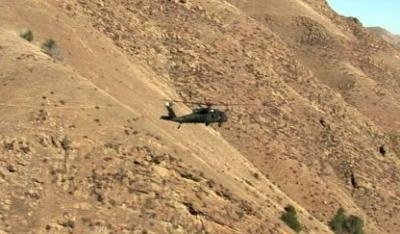Mon, Dec 10, 2012
First Test Flight Had Pilots Aboard For Safety
Over the skies east of San Jose, CA, a Black Hawk helicopter was seen flying low and slow November 5. There were pilots aboard the aircraft, but all maneuvers during this flight were being conducted autonomously.

The U.S. Army Research, Development and Engineering Command's Aviation and Missile Center successfully demonstrated low-level autonomous behaviors in a flight over the Diablo Range. This demonstration is critical to the next generation of technological advances in military rotorcraft: obstacle field navigation and safe landing area determination.
Terrain sensing, statistical processing, risk assessment, threat avoidance, trajectory generation, and autonomous flight control were performed in real-time during the two-hour test flight. "This was the first time terrain-aware autonomy has been achieved on a Black Hawk," said Lt. Col. Carl Ott, chief of the Flight Projects Office at AMRDEC's Aero Flight Dynamics Directorate.
Testing was conducted on the Rotorcraft Aircrew Systems Concept Airborne Laboratory, or RASCAL, a JUH-60A Black Hawk equipped with the H.N. Burns 3D-LZ laser detection and ranging system for terrain sensing. "The RASCAL aircraft was the ideal platform to demonstrate this technology. It provides a fully programmable, fly-by-wire flight control system and [has] advanced sensor interfaces for rapid prototyping of new concepts while maintaining the standard UH-60 hydro-mechanical flight control system as a safety backup," said Jay Fletcher, RASCAL project manager.
Throughout the flight, the aircraft maintained an altitude of 200 and 400 feet above ground. During the final obstacle of the field navigation flight, the safe landing area determination algorithm autonomously identified a safe landing spot within a forest clearing and commanded the aircraft to approach and hover at 60 feet.
Final hover was accurate within a foot.
"A risk-minimizing algorithm was used to compute and command a safe trajectory continuously throughout 23 miles of rugged terrain at an average speed of 40 knots," said Matthew Whalley, the Autonomous Rotorcraft Project lead. "No prior knowledge of the terrain was used."
Crew members on the historic flight were Army experimental test pilots Lt. Col. Mike Olmstead and Ott, RASCAL system operator Dennis Zollo, and Dr. Marc Takahashi.
More News
With Testing Soon Complete, Launch Preparations Begin in Earnest Sierra Space's Dream Chaser has been put through the wringer at NASA's Glenn Armstrong Test Facility in Ohio, but w>[...]
Takeoff Roll The process whereby an aircraft is aligned with the runway centerline and the aircraft is moving with the intent to take off. For helicopters, this pertains to the act>[...]
“We’re proud of the hard work that went into receiving this validation, and it will be a welcome relief to our customers in the European Union. We couldn’t be mor>[...]
"Aircraft Spruce is pleased to announce the acquisition of the parts distribution operations of Wag-Aero. Wag-Aero was founded in the 1960’s by Dick and Bobbie Wagner in the >[...]
IDENT Feature The special feature in the Air Traffic Control Radar Beacon System (ATCRBS) equipment. It is used to immediately distinguish one displayed beacon target from other be>[...]
 Sierra Space Repositions Dream Chaser for First Mission
Sierra Space Repositions Dream Chaser for First Mission ANN's Daily Aero-Term (05.10.24): Takeoff Roll
ANN's Daily Aero-Term (05.10.24): Takeoff Roll Aero-News: Quote of the Day (05.10.24)
Aero-News: Quote of the Day (05.10.24) Aero-News: Quote of the Day (05.11.24)
Aero-News: Quote of the Day (05.11.24) ANN's Daily Aero-Term (05.11.24): IDENT Feature
ANN's Daily Aero-Term (05.11.24): IDENT Feature



